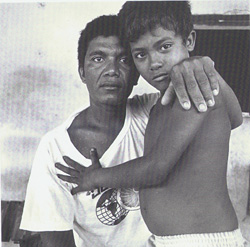 
Africa's Legacy in
Mexico
Oaxaca Diary
|

"My Father, My Son," Corralero,
Oaxaca, Mexico, 1991
OAXACA DIARY
Tony Gleaton
Corralero, Oaxaca, Mexico, 1988
In the darkness of early morning, I ready myself
to leave. One of the trucks that will take the women to market can be heard
in the distance, sounding its horn in short, repetitive beeps.
I struggle with my effort to adjust myself to not being asleep, while
rolling up my sleeping mat and receiving a cup of coffee from my perpetual
host, Dominga Soliz. Seemingly, I pass from one dream state to another in
this last hour before dawn.
In the near distance the truck that will eventually carry me and my few
possessions to town rounds the corner down near the lagoon. Its beams of
light slash the darkness, illuminating the figures struggling with large
canastas of fish that will be loaded and sold at market today.
Dominga smiles lovingly at me. In a sense I have become a small part
of the village. It has been that way for nearly five years, ever since I
came to photograph this area just south of Acapulco, a place I have come
to view simply as a present-day reminder of black Africa's legacy in Mexico.
For a long time I felt I was taking pictures of things that mattered to
me and no one else. These villagers, who became friends, sustained my quest;
their effort to win long-sought recognition by Mexican society inspired
me to travel many miles to return here time and time again. Now, as always,
everyone is more than helpful when I ask permission to photograph. There
is often no question about my repositioning subjects to create an effect,
or having fathers embrace sons at my suggestion rather than theirs. The
photographs that I create are as much an effort to define my own life, with
its heritage encompassing Africa and Europe, as an endeavor to throw open
the discourse on the broader aspects of "mestizaje," the "assimilation"
of Asians, Africans, and Europeans with indigenous Americans.
The truck now stops before me. Loaders secure my bicycle and backpack
to the iron stays that support the canvas roof. I, along with the village
women, sit perched on planks suspended over the cargo below.
Huddled in the near darkness, bounding down a rut-filled road, I realize
that I am engaged in the same balancing act as my fellow passengers, as
we cling to whatever support is available in this journey as well as in
our lives.

|